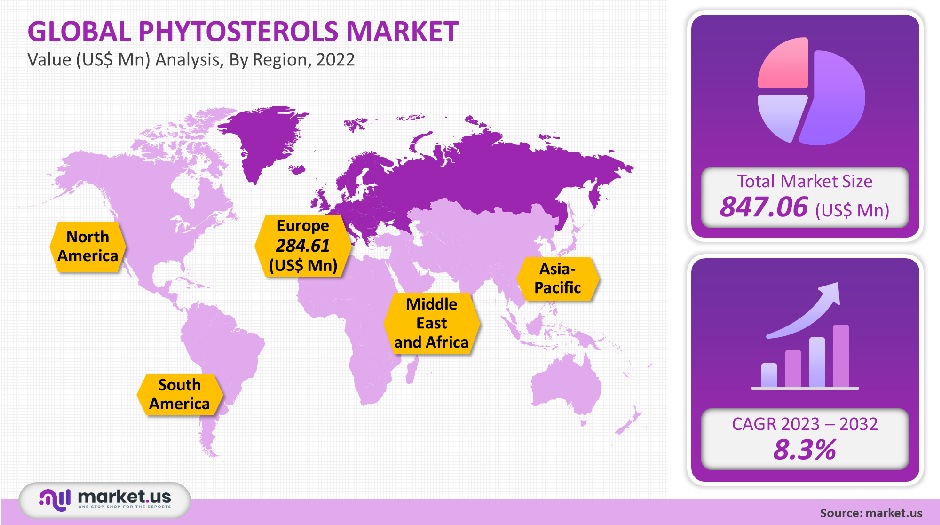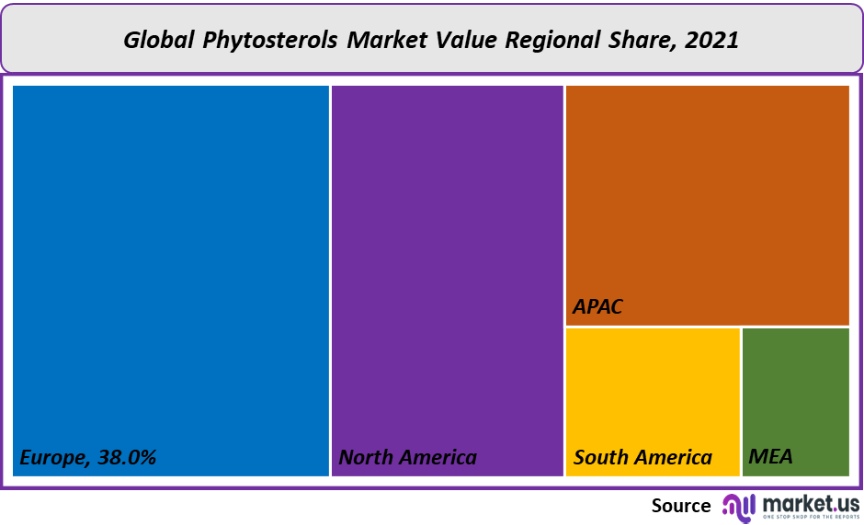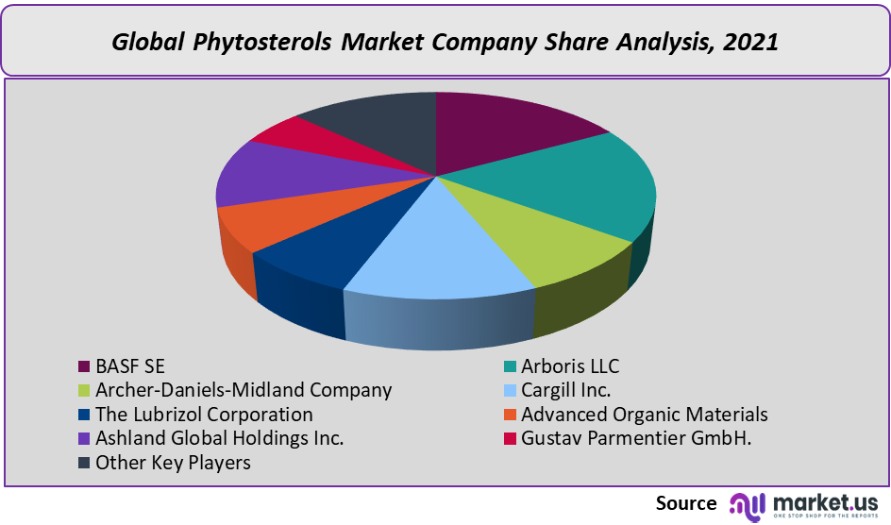Global Phytosterols Market By Product (Campesterol, Stigmasterol, Beta-Sitosterol, and Other products), By Application (Plastics, Inks, and Coatings), and by Region and Companies Industry Segment Outlook, Market Assessment, Competition Scenario, Trends and Forecast 2022-2032.
- Published date: Nov 2021
- Report ID: 18323
- Number of Pages: 322
- Format:
- keyboard_arrow_up
Phytosterols Market Overview:
The global market for phytosterols was valued at USD 847.06 million in 2021 and is forecast to experience a revenue-based CAGR of 8.3% over the forecast period.
Nutraceutical products are in high demand because of the increasing acceptance of healthy lifestyles across different geographies.
Global Phytosterols Market Analysis
Product Analysis
Beta-Sitosterol is a compound that can be extracted from vegetable oils and woods. It’s used extensively in dairy products, drinks, and as an ingredient in dietary supplements. For body fat reduction, an increasing number of obese individuals consume 1.5g to 5g of beta-sitosterol each day. Consumers are more concerned about their health and nutrition, which has positively affected the demand for beta-sitosterol.
Campesterol can be used as a food ingredient and also as a dietary supplement because of its cholesterol-lowering properties. Increasing demand for phytosterol-fortified nutritional supplements and food products is projected to drive the product demand in the food ingredient segment over the forecast period.
Stigmasterol and its derivatives, including stigma-4-en-3-one, spinasterol, stigmasterol glucoside, fucosterol, and 29-fluorostigmasterol, act as intermediates in the production of vitamin D3. Vitamin D3 helps prevent bone diseases such as osteomalacia, rickets, and other conditions. This makes stigmasterol an ideal candidate for pharmaceutical use. Over the forecast period, new avenues will be opened in the phytosterols industry due to research that aims at developing stigmasterol to prevent breast and colon carcinoma.

Application Analysis
The most prominent uses of phytosterols products are in the pharmaceutical, cosmetics, and food industries. The pharmaceutical sector includes creams, tablets, and medicinal products. A combination of increased cholesterol levels in the elderly and the increasing prevalence of lifestyle diseases, as well as other health conditions, has led to a rise in the use of phytosterols for pharmaceutical purposes.
In the cosmetics industry, phytosterols derivatives/formulations find application in creams, skincare, hair care, sun care, and oral care products. Keratinized cells make up the outermost layer. These cells contain ceramides, sterols, and free fatty acids. The skin is protected from the entry of exogenous substances by the sterols. They regulate skin moisture levels and prevent skin water loss. The cosmetic use of phytosterols ensures soft and healthy skin, which is why they are so popular in cosmetic products.The food industry uses phytosterols as an ingredient in spreads, cream, cheese, turkey liver, sausage, and mayonnaise. Their ability to lower the absorption of cholesterol in the gastrointestinal system means that they can be added to foods. Because phytosterol has many health benefits, it is expected that there will be a higher demand for this ingredient in food products.
Key Market Dynamics
By Product
- Campesterol
- Stigmasterol
- Beta-Sitosterol
- Other products
By Application
- Cosmetics
- Pharmaceutical
- Food Ingredients
- Other Applications
Market Dynamics
The rising demand for dietary vitamins that complement cardiovascular health is expected to lead to an increase in phytosterols used as functional ingredients. This trend is further supported by rising healthcare and pharmaceutical costs. A lower margin for vegetable oil extraction and bio-refineries is likely to limit the growth of the market in phytosterols. The growth rate is expected to rise due to biotechnological innovation in the near future.
Bio-based and sustainable ingredients are being used in many industries due to increasing concern about the effects of chemical additives on the environment. The manufacturing sector is shifting its focus toward incorporating bio-based/plant-based raw materials to reduce carbon footprint and gain consumer confidence by providing products having fewer or no side effects.
A wide range of products made from mature plants is available in the cosmetics market, due to the increasing demand for bio-based cosmetics. Phytosterols are used as cosmetic ingredients in personal care products and cosmetics, such as anti-aging creams. A phytosterol-based product profile, combined with skin-replenishing benefits, is projected to drive the growth of the market over the forecast period.
Europe was one of the first to adopt the bio-based economic model.A report by the European Commission entitled “A sustainable Bioeconomy for Europe” states that the European adoption of a bioeconomy greatly supports the strengthening and modernization of the region’s industrial base through the creation of new value chains that are more green, efficient, and less expensive. The growth of certain industries like cosmetics has been significantly affected by the development of biotechnology.
Regional Analysis
Europe has dominated the market for phytosterols in all regions. accounted for the highest revenue share of 38% among the others. It is also expected to grow at an impressive rate over the forecast period. The European market is seeing a significant increase in product demand, mainly due to the established food, cosmetics, and pharmaceutical industries in the U.K. The region’s early adoption of the bio-based economy has helped to accelerate the demand for bio-based products across many end-use industries like cosmetics.
North America is closely followed by Europe in terms of market value. Other lucratively growing regions include the Asia Pacific, and Central and South America. In comparison to other regions, the Middle East is likely to see slower market growth due to lower awareness and less adoption of nutraceuticals.

Key Regions and Countries covered іn thе rероrt:
- North America
- US
- Canada
- Mexico
- Europe
- Germany
- UK
- France
- Italy
- Russia
- Spain
- Rest of Europe
- APAC
- China
- Japan
- South Korea
- India
- Rest of Asia-Pacific
- South America
- Brazil
- Argentina
- Rest of South America
- MEA
- GCC
- South Africa
- Israel
- Rest of MEA
Market Share & Key Players Analysis:
These companies use tall oil, fat acid derivatives, and sunflower oil as the main feedstock to produce phytosterol. The top market players have invested heavily in R&D in order to optimize their production processes in order increase their profitability.
Acquisitions and mergers are often expensive, time-consuming, and complex, particularly for smaller players. If this is the case, manufacturers will benefit from a strategic alliance where two companies supply different ingredients and develop new products through R&D.

Маrkеt Кеу Рlауеrѕ:
- BASF SE
- Arboris LLC
- Archer-Daniels-Midland Company
- Cargill Inc.
- The Lubrizol Corporation
- Advanced Organic Materials
- Ashland Global Holdings Inc.
- Gustav Parmentier GmbH.
- Other Key Players
For the Phytosterols Market research study, the following years have been considered to estimate the market size:
Attribute Report Details Historical Years
2016-2020
Base Year
2021
Estimated Year
2022
Short Term Projection Year
2028
Projected Year
2023
Long Term Projection Year
2032
Report Coverage
Competitive Landscape, Revenue analysis, Company Share Analysis, Manufacturers Analysis, Volume by Manufacturers, Key Segments, Key company analysis, Market Trends, Distribution Channel, Market Dynamics, COVID-19 Impact Analysis, strategy for existing players to grab maximum market share, and more.
Regional Scope
North America, Europe, Asia-Pacific, South America, Middle East & Africa
Country Scope
United States, Canada and Mexico, Germany, France, UK, Russia and Italy, China, Japan, Korea, India and Southeast Asia, Brazil, Argentina, Colombia etc.Saudi Arabia, UAE, Egypt, Nigeria and South Africa
Frequently Asked Questions (FAQ)
Q: What is the Phytosterols market size in 2021?A: The Phytosterols market size is US$ 847.06 million for 2021.
Q: What is the CAGR for the Phytosterols market?A: The Phytosterols market is expected to grow at a CAGR of 8.3% during 2023-2032.
Q: What are the segments covered in the Phytosterols market report?A: Market.US has segmented the Global Phytosterols Market Value (US$ Mn) Analysis by Region, 2022 market by geographic (North America, Europe, APAC, South America, and Middle East and Africa). By Product, market has been segmented into campesterol, stigmasterol, beta-sitosterol, and other products. By Application, the market has been further divided into cosmetics, pharmaceutical, food ingredients, and other applications.
Q: Who are the key players in the Phytosterols market?A: BASF SE, Arboris LLC, Archer-Daniels-Midland Company, Cargill Inc., The Lubrizol Corporation, Advanced Organic Materials, Ashland Global Holdings Inc., Gustav Parmentier GmbH., and Other Key Players are the key vendors in the Phytosterols market.
Q: Which region is more attractive for vendors in the Phytosterols market?A: Europe accounted for the highest revenue share of 38% among the other regions. Therefore, the Phytosterols market in Europe is expected to garner significant business opportunities for the vendors during the forecast period.
Q: What are the key markets for Phytosterols?A: Key markets for Phytosterols are US, China, Japan, India, Brazil, Germany, UK, France, Italy, Spain, etc.
Q: Which segment has the largest share in the Phytosterols market?A: In the Phytosterols market, vendors should focus on grabbing business opportunities from the beta-sitosterol product segment as it accounted for the largest market share in the base year.
![Phytosterols Market Phytosterols Market]()
- BASF SE Company Profile
- Arboris LLC
- Archer-Daniels-Midland Company
- Cargill Inc.
- The Lubrizol Corporation
- Advanced Organic Materials
- Ashland Global Holdings Inc. Company Profile
- Gustav Parmentier GmbH.
- Other Key Players
- settingsSettings
Our Clients
|
Single User
$5,999
$2,999
USD / per unit
save 50% |
Multi User
$7,999
$3,499
USD / per unit
save 55% |
Corporate User
$12,999
$4,499
USD / per unit
save 65% | |
|---|---|---|---|
| e-Access | |||
| Data Set (Excel) | |||
| Company Profile Library Access | |||
| Interactive Dashboard | |||
| Free Custumization | No | up to 10 hrs work | up to 30 hrs work |
| Accessibility | 1 User | 2-5 User | Unlimited |
| Analyst Support | up to 20 hrs | up to 40 hrs | up to 50 hrs |
| Benefit | Up to 20% off on next purchase | Up to 25% off on next purchase | Up to 30% off on next purchase |
| Buy Now ($ 2,999) | Buy Now ($ 3,499) | Buy Now ($ 4,499) |









